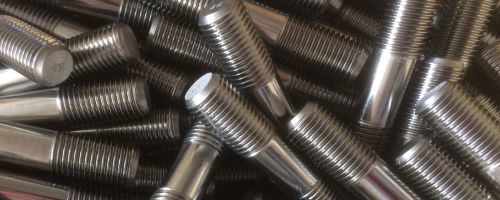Stud Bolts
Stainless Steel Stud Bolts
A Stud bolts is made up of three parts: a massive steel nut, a threaded steel rod, and another huge steel nut. Flanged couplings rely heavily on stud bolts and nuts for best sealing.
Stud bolts manufacture come in a range of sizes and lengths, both metric and imperial, and a wide range of materials, from carbon steel to alloy, stainless, and nickel alloys (common grades are: ASTM A193 B7, L7, B8, B8M, B16, Alloy 20, Monel, Hastelloy, Inconel, 17-4PH, titanium, etc.). These grading scales will be explained in more detail below.
ASME B16.5 specifies stud bolts and nuts for ASME flanges based on flange diameter, pressure class, and face finish (RF, FF, RTJ).
STUD BOLT (THREADED ROD)
Studs are threaded rods placed into the holes of the mating flanges and then have their ends tightened using steel nuts.
Stud bolt length (OAL/FTF)
Overall length (i.e. "OAL") and "first usable thread to first usable thread" (i.e. "FTF") are both good ways to describe the length of the stud.
As the industry standard, the FTF length is determined by subtracting a quarter of an inch from the OAL length.
Stud bolt thread pitch and thread series
ASME B1.1 requires that the stud be threaded in a specified way, and that's exactly what we did.
The "thread pitch," or thread angle, is defined as the number of threads per inch.
It is simpler for the manufacturer to examine threads with a symmetrical thread pitch and a "V-profile" (60 degrees); hence they are the most common.
A number of threads per inch (or "TPI") is a standard unit of measurement for thread pitch relative to a particular thread diameter.
When it comes to fasteners, the Universal Nut and Bolt Coarse (UNC) series are by far the most frequent. Low-strength threads require coarser Iron, mild steel, copper, and softer alloys like aluminium and stainless steel are all examples of thread materials. The coarser thread may withstand rougher treatment and is easier to put together.
In the fine thread series (UNF/UNRF), UNF is often utilised for precision work and situations where higher tensile strength is required (vs the coarse thread series)
For various ASTM standards, including A193 B7, A193 B8/B8M, and A320, the 8-Thread series (8UN) is the preferred threading system. Inches and above in diameter are typical applications for this series.
All stud bolts with a diameter of 1" or more that fall under the ASTM A193 or A320 Specifications have 8UN threading, which translates to 8 threads per inch. Unless specified by the corresponding ASTM rule, the customer specifies the thread pitch for all other material grades.
NUTS FOR STUD BOLTS
For a stud to be secured, two large hex steel nuts must be tightened onto the rod's ends.
By slightly lengthening the bolt and compressing the two linked pieces, friction between the threads of the stud and the steel nuts creates a flawless fit.
STUD VS BOLT
A common question is what is the difference between stud and bolts?
By slightly lengthening the bolt and compressing the two linked pieces, friction between the threads of the stud and the steel nuts creates a flawless fit.
STUD BOLT MATERIALS
Most stud bolts (for flanges) are made of ASTM A193 (grade B7, B8, B8M, B8T), ASTM A453 (grade 660), ASTM A320 (grade L7, L7M), or ASTM A182 (grade 316). (duplex and super duplex bolting). Coating stud bolts with Xylan, Xylar, or another substance is an option for use in hostile fluids and conditions.


Comments
Post a Comment